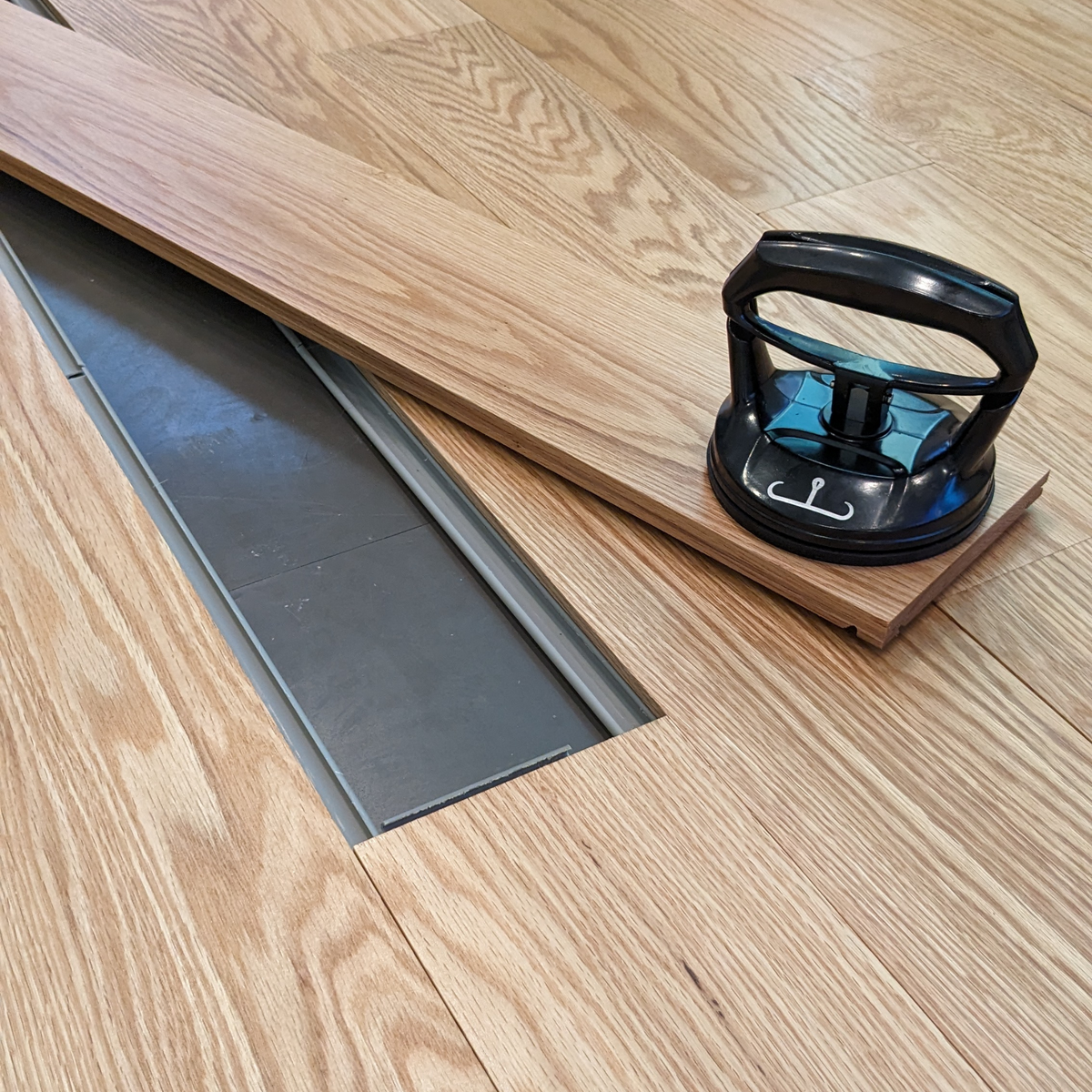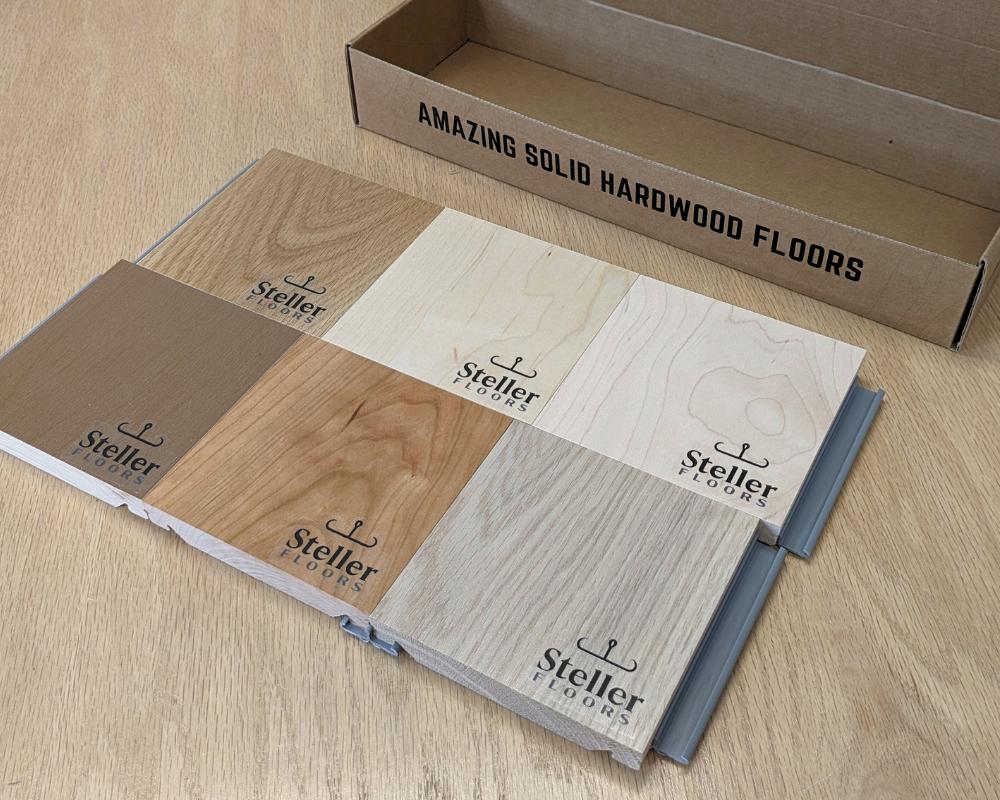Do I need to acclimate my Steller Floor before Installation?
Steller Floors are made of the highest quality, kiln-dried solid wood and they are milled to precise tolerances under climate control in our manufacturing facility. Our woodshop is set at 70-75 degrees F and 45% RH, year-round. Then, we seal the planks on all sides: polyurethane on the wear surface, and paraffin wax on the other sides--which keeps the plank stable in shipping and in your home. Then, we take another step of sealing the planks in shrink-wrap before shipment.
Temporary Dimensional Changes During Acclimation
All floors (including LVP!) adjust to their new climates with subtle and temporary dimensional change as they absorb humidity in more damp climates or dry out in more arid climates. When folks acclimate floors in a stack, these changes happen out of sight.
If you install your Steller Floor immediately after receiving it, your perfect Steller planks will go through this process right in front of your eyes. You may see slight and temporary lippage, gapping, warping or bowing - and then the planks gradually return to perfect.
As long as your interior humidity is where you want it in the long term - this process will be the last step to finalizing your installation.
Professionals who understand that this adjustment is a normal part of installation will recognize that clients who are less confident about these processes will benefit from acclimating in a stack instead of installing immediately.
How do I know my planks are ready to install?
If your long-term interior humidity is outside 40-50% RH, you should take time to acclimate. You can track the progress of your floor towards readiness by holding two planks face-to-face. If the planks have a gap, they are not ready yet. Wait until the planks sit flat against each other to install.
How long does acclimation take?
If your home is outside the recommended range (35-50% RH), that's generally ok! Especially in arid regions, your interior space may be significantly drier than the human comfort zone. In these cases, we recommend acclimating your Steller Floor for 2 weeks for every 5% RH your space is outside the range. For example, if your home is at 30% RH, you should acclimate your floor for about two weeks (see below).
Do I need to control the humidity in my home with a Steller Floor?
Yes and no. Humidity is an important measure inside every home to help prevent mold growth, care for wood products, and for your own personal health. If you aren't sure how to control it, don't worry. It is easy and cost-effective, and we have pointers for that!
- How do I control the humidity in my home?
That said, if you prefer to have a more "outdoor" living experience during some seasons - that's ok too - with a few provisos.
1) Thrill-Seekers. If you really want mother nature making the calls with windows open 24 hours a day, plan ahead. You will want to prepare your expansion gaps for the thrill of seeing wood science in action. Your Steller Floor will be fine - and is built for this. But it will move - so proper expansion gaps help enormously.
2) Balanced Fresh Air Seekers. If you can only open windows when you are home - and control your climate for at least half the day - your wood floors will move half as much. Wood detects and responds to average humidity changes over weeks - not hours or days.
3) Hermetic Sealers. Wood only responds to changes in humidity. If you want your floor to need smaller expansion gaps for ultramodern baseboards, or if you want to play it safe - keep your HVAC system with humidity control running at 45% RH year round. It neither needs to be expensive nor complicated.
1) Expensive route - very high end HVAC systems ($10K+) can control humidity with extreme precision for all of your data logging needs.
2) Basic route - add a humidification element to your HVAC for $200-$1000 and keep track of your humidity throughout your home.
3) Ultra cheap - Grab a basic dehumidifier from a box store and a humidity sensor from the lawn and garden section. Now you can have a perfect floor for less than $300.
If I need to, how do I properly acclimate my Steller Hardwood Floor?
Acclimating a Steller Hardwood Floor is basically the same as any other solid hardwood floor: once your space has reached your desired temperature and RH, remove the flooring planks from the packages and set the flooring in the room where it is intended to be installed. If at all possible, use spacers between layers of wood so that air can access as much surface area as possible. It is always a good idea to acclimate flooring outside of direct sunlight and to circulate the air in the room using a fan to help the floors get used to the space.

The above drawing shows an "open stack" or a way of consuming a small amount of floor space while exposing your planks to as much air in the room as possible. If you look carefully, the planks a laid "face to face" and "back to back" to reduce wax transfer from the back of the planks to the front. If you accidentally get wax on the face of the planks - no worries - just buff it off.
Why do most other hardwood floors need to be acclimated and a Steller Floor doesn't?
That is a great question! Most other hardwood flooring companies do not climate control their facilities, either due to expense or inconvenience (or both). That means that the wood in the facility responds to exposure to outdoor air during manufacturing.
Ever wonder why your old hardwood floor planks don't seem milled precisely? A lack of climate control during milling is one good reason.
When other hardwood floors are brought indoors, they need to get used to a new temperature and humidity--which is why they need to sit for two weeks before you can install them.
Interesting, right? ;)
Reach out for Steller Support!
We can help you troubleshoot over the phone, by email, or by video appointment from our studio! 1-800-955-7671 or support@floorsbysteller.com







